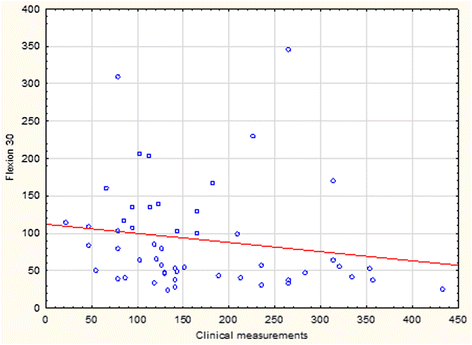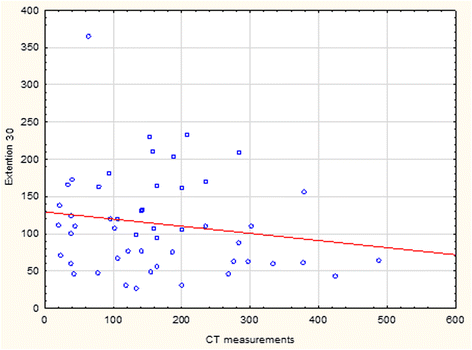Giant ventral hernia-relationship between abdominal wall muscle strength and hernia area
- PMID: 27484911
- PMCID: PMC4970278
- DOI: 10.1186/s12893-016-0166-x
Giant ventral hernia-relationship between abdominal wall muscle strength and hernia area
Abstract
Background: Symptoms arising from giant ventral hernia have been considered to be related to weakening of the abdominal muscles. The aim of this study was to investigate the relationship between the area of the abdominal wall defect and abdominal wall muscle strength measured by the validated BioDex system together with a back/abdominal unit.
Methods: Fifty-two patients with giant ventral hernia (>10 cm wide) underwent CT scan, clinical measurement of hernia size and BioDex measurement of muscle strength prior to surgery. The areas of the hernia derived from CT scan and from clinical measurement were compared with BioDex forces in the modalities extension, flexion and isometric contraction. The Spearman rank test was used to calculate correlations between area, BMI, gender, age, and muscle strength.
Result: The hernia area calculated from clinical measurements correlated to abdominal muscle strength measured with the Biodex for all modalities (p-values 0.015-0.036), whereas no correlation was seen with the area calculated by CT scan. No relationship was seen between BMI, gender, age and the area of the hernia.
Discussion: The inverse correlation between BioDex abdominal muscle strength and clinically assessed hernia area, seen in all modalities, was so robust that it seems safe to conclude that the area of the hernia is an important determinant of the degree of loss of abdominal muscle strength. Results using hernia area calculated from the CT scan showed no such correlation and this would seem to concur with the results from a previous study by our group on patients with abdominal rectus diastasis. In that study, defect size assessed clinically, but not that measured by CT scan, was in agreement with the size of the diastasis measured intra-operatively. The point at which the area of a hernia begins to correlate with loss of abdominal wall muscle strength remains unknown since this study only included giant ventral hernias.
Keywords: Abdominal muscle strength; Biodex; Giant ventral hernia; Hernia area.
Figures



Similar articles
-
Assessment of abdominal muscle function using the Biodex System-4. Validity and reliability in healthy volunteers and patients with giant ventral hernia.Hernia. 2011 Aug;15(4):417-21. doi: 10.1007/s10029-011-0805-1. Epub 2011 Mar 5. Hernia. 2011. PMID: 21380564
-
[Remodeling of muscular layer of abdominal wall in patients with postoperative ventral hernia].Khirurgiia (Mosk). 2025;(4):46-52. doi: 10.17116/hirurgia202504146. Khirurgiia (Mosk). 2025. PMID: 40203171 Russian.
-
Isometric abdominal wall muscle strength assessment in individuals with incisional hernia: a prospective reliability study.Hernia. 2016 Dec;20(6):831-837. doi: 10.1007/s10029-016-1497-3. Epub 2016 May 12. Hernia. 2016. PMID: 27169719
-
[A rare cause of acute small bowel obstruction: incarcerated Spieghelian hernia. Case-report and literature review].Morphologie. 2012 Mar;96(312):12-5. doi: 10.1016/j.morpho.2012.02.002. Epub 2012 Mar 22. Morphologie. 2012. PMID: 22445528 Review. French.
-
Diagnostic techniques for diastasis recti.Hernia. 2021 Aug;25(4):915-919. doi: 10.1007/s10029-021-02469-7. Epub 2021 Jul 27. Hernia. 2021. PMID: 34313855 Review.
Cited by
-
The causal association between body fat distribution and risk of abdominal wall hernia: a two-sample Mendelian randomization study.Hernia. 2024 Apr;28(2):599-606. doi: 10.1007/s10029-023-02954-1. Epub 2024 Jan 31. Hernia. 2024. PMID: 38294577
-
Impact of incisional hernia on abdominal wall strength.BJS Open. 2024 May 8;8(3):zrae045. doi: 10.1093/bjsopen/zrae045. BJS Open. 2024. PMID: 38818958 Free PMC article. No abstract available.
-
Truncal function after abdominal wall reconstruction via transversus abdominis muscle release (TAR) for large incisional hernias: a prospective case-control study.Hernia. 2022 Oct;26(5):1285-1292. doi: 10.1007/s10029-022-02563-4. Epub 2022 Jan 11. Hernia. 2022. PMID: 35018559
-
Quality of life and abdominal wall functionality after abdominal wall reconstruction: A prospective single center follow-up study.Hernia. 2024 Dec;28(6):2223-2234. doi: 10.1007/s10029-024-03143-4. Epub 2024 Sep 6. Hernia. 2024. PMID: 39240469 Free PMC article.
-
Evaluation of rectus abdominis muscle strength and width of hernia defect in patients undergoing incisional hernia surgery.Hernia. 2023 Aug;27(4):919-926. doi: 10.1007/s10029-023-02834-8. Epub 2023 Jul 13. Hernia. 2023. PMID: 37442870
References
-
- Goodenough CJ, Ko TC, Kao LS, Nguyen MT, Holihan JL, Alawadi Z, Nguyen DH, Flores JR, Arita NT, Roth JS, Liang MK. Development and validation of a risk stratification score for ventral incisional hernia after abdominal surgery: hernia expectation rates in intra-abdominal surgery (the HERNIA Project) J Am Coll Surg. 2015;220(4):405–13. doi: 10.1016/j.jamcollsurg.2014.12.027. - DOI - PMC - PubMed
-
- Klinge U, Si ZY, Zheng H, Schumpelick V, Bhardwaj RS, Klosterhalfen B. Collagen I/III and matrix metalloproteinases (MMP) 1 and 13 in the fascia of patients with incisional hernias. J Invest Surg. 2001;14(1):47-54. - PubMed
-
- Mingoli A, Puggioni A, Sgarzini G, Luciani G, Corzani F, Ciccarone F, Baldassarre E, Modini C. Incidence of incisional hernia following emergency abdominal surgery. Ital J Gastroenterol Hepatol. 1999;31(6):449–53. - PubMed
Publication types
MeSH terms
LinkOut - more resources
Full Text Sources
Other Literature Sources

